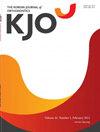Occlusal deviations in adolescents with idiopathic and congenital scoliosis
IF 1.9
3区 医学
Q1 Dentistry
引用次数: 2
Abstract
Objective This cross-sectional study aimed to investigate the characteristics of malocclusions in scoliotic patients through clinical examinations. Methods Fifty-eight patients with idiopathic scoliosis (IS) and 48 patients with congenital scoliosis (CS) participated in the study. A randomly selected group of 152 orthopedically healthy children served as the control group. Standardized orthodontic and orthopedic examination protocols were used to record the occlusal patterns and type of scoliosis. Assessments were made by three experienced orthodontists and a spinal surgery team. The differences in the frequency distribution of occlusal patterns were evaluated by the chi-squared test. Results In comparison with patients showing IS, patients with CS showed a higher incidence of Cobb angle ≥ 45° (p = 0.020) and included a higher proportion of patients receiving surgical treatments (p < 0.001). The distribution of the Angle Class II subgroup was significantly higher in the IS (p < 0.001) and CS (p = 0.031) groups than in the control group. In comparison with the healthy controls, the CS and IS groups showed significantly higher (p < 0.05) frequencies of asymmetric molar and asymmetric canine relationships, upper and lower middle line deviations, anterior deep overbite, unilateral posterior crossbite, and canted occlusal plane, with the frequencies being especially higher in CS patients and to a lesser extent in IS patients. Conclusions Patients with scoliosis showed a high frequency of malocclusions, which were most obvious in patients with CS.青少年特发性和先天性脊柱侧凸的咬合偏差
目的通过临床检查,探讨脊柱侧凸患者错牙合的特点。方法对58例特发性脊柱侧凸(IS)患者和48例先天性脊柱侧凸(CS)患者进行研究。随机抽取152例骨科健康儿童作为对照组。标准化的正畸和矫形检查方案被用来记录咬合模式和脊柱侧凸的类型。由三名经验丰富的正畸医生和一个脊柱外科小组进行评估。咬合模式频率分布的差异采用卡方检验。结果与IS患者相比,CS患者Cobb角≥45°的发生率更高(p = 0.020),接受手术治疗的患者比例更高(p < 0.001)。IS组(p < 0.001)和CS组(p = 0.031)的Angle Class II亚组分布明显高于对照组(p < 0.001)。与健康对照组相比,CS组和IS组磨牙不对称、犬齿不对称、上下中线偏差、前牙深覆合、单侧后牙合、咬合平面倾斜的发生率均显著升高(p < 0.05),其中CS组发生率最高,IS组发生率较低。结论脊柱侧凸患者错牙合发生率高,以脊柱侧凸患者最为明显。
本文章由计算机程序翻译,如有差异,请以英文原文为准。
求助全文
约1分钟内获得全文
求助全文
来源期刊

Korean Journal of Orthodontics
Dentistry-Orthodontics
CiteScore
2.60
自引率
10.50%
发文量
48
审稿时长
3 months
期刊介绍:
The Korean Journal of Orthodontics (KJO) is an international, open access, peer reviewed journal published in January, March, May, July, September, and November each year. It was first launched in 1970 and, as the official scientific publication of Korean Association of Orthodontists, KJO aims to publish high quality clinical and scientific original research papers in all areas related to orthodontics and dentofacial orthopedics. Specifically, its interest focuses on evidence-based investigations of contemporary diagnostic procedures and treatment techniques, expanding to significant clinical reports of diverse treatment approaches.
The scope of KJO covers all areas of orthodontics and dentofacial orthopedics including successful diagnostic procedures and treatment planning, growth and development of the face and its clinical implications, appliance designs, biomechanics, TMJ disorders and adult treatment. Specifically, its latest interest focuses on skeletal anchorage devices, orthodontic appliance and biomaterials, 3 dimensional imaging techniques utilized for dentofacial diagnosis and treatment planning, and orthognathic surgery to correct skeletal disharmony in association of orthodontic treatment.
 求助内容:
求助内容: 应助结果提醒方式:
应助结果提醒方式:


